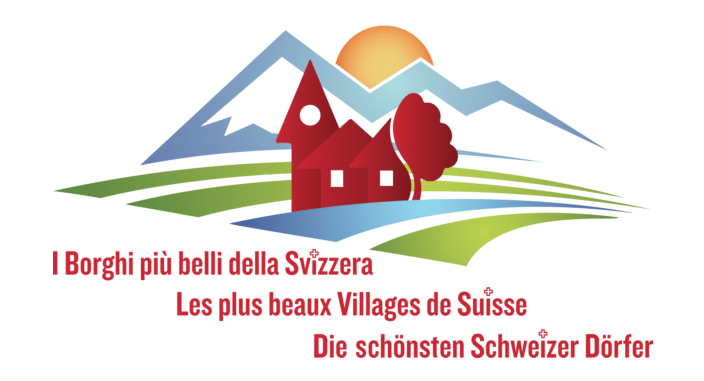22 of the Most Beautiful Villages in Switzerland
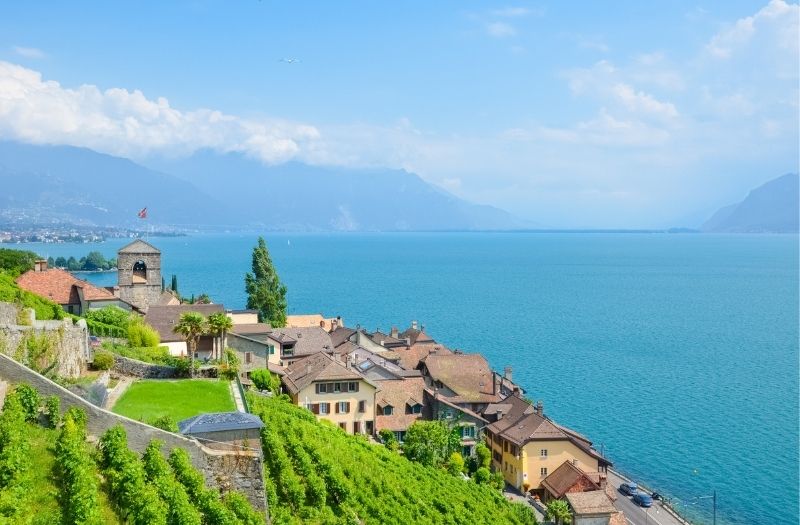
If you love exploring authentic villages on your travels, you’ll love this guide to 22 of the most beautiful villages in Switzerland.
Although there are many well-known villages in Switzerland that are widely acclaimed for their beauty, there are plenty of charming villages that are far less visited but no less beautiful.
In fact, the villages we’ve covered below could easily make a list of fairytale villages in Switzerland. They are all picture-perfect but they also have historic significance and plenty of charm.
The villages mentioned below are all members of the Most Beautiful Villages in Switzerland association – and all are well worth a visit.
Read on to discover 22 of the most beautiful villages in Switzerland.
[This post may contain compensated links. Please see my disclosure policy for more information.]

What's in this Article
The Most Beautiful Villages in Switzerland association
Les Plus Beaux Villages de Suisse (or the Most Beautiful Villages in Switzerland) is an association set up to recognise the beauty and significance of villages that have a particular charm and retain their historic architecture and culture.
The ‘beaux villages’ association first began in France in 1982 and the International Federation Les Plus Beaux Villages de la Terre is now joined by a number of countries, including Switzerland, Spain and Italy, who believe it is important to preserve the history and specific characteristics of their villages.
When it comes to beautiful villages, Switzerland has them in abundance but not just any village can be become a member of the association.
In order to be admitted to the Swiss association, each municipality must meet certain requirements.
For example, in the oldest part of the village (the historic centre), the population must be under 2000 inhabitants and the entire municipality cannot exceed 10,000 inhabitants, at the time of admission.
The village must also have a certain homogeneity of its historic centre, have particular houses, churches and cultural buildings and it is a plus to have a museum or areas where temporary exhibitions are held.
The history of a village is also important.
For instance, Gersau in Canton Schwyz, was once the smallest republic in the world. The surrounding landscape can also play a key role: belonging to a regional park, for example, is considered a plus.
There are currently 49 members of the Most Beautiful Villages of Switzerland including one village from neighbouring Liechtenstein. You can find a complete list of all member villages at the end of this article.
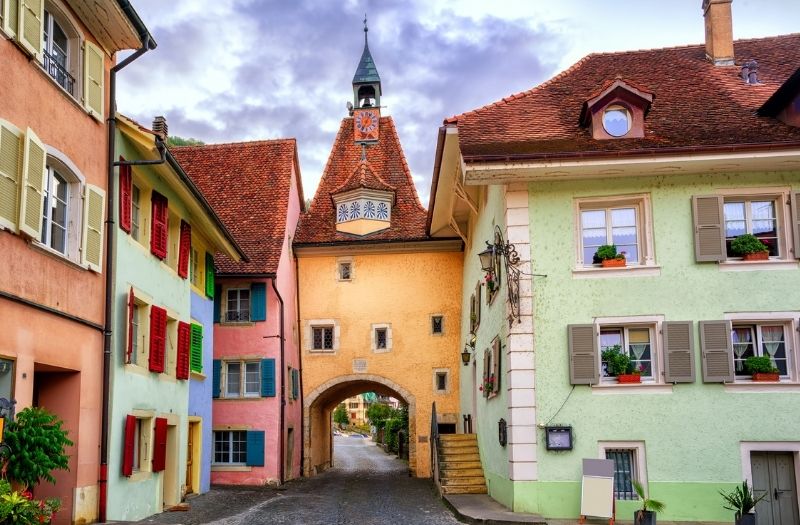
22 of the Most Beautiful Villages in Switzerland and Liechtenstein
Whilst all 49 of the villages are charming in their own right, we’ve chosen 22 to cover in further detail below. Why not include one of two of these villages in your Switzerland itinerary?
Be warned – choosing which ones to visit will be a difficult choice!
Switzerland’s public transport network is excellent and most villages are serviced by either trains or buses. If you plan to travel by public transport, consider a Swiss Travel Pass which covers all train and bus travel within the country.
Should you prefer a little more flexibility with your timetable, driving in Switzerland gives you the option to stay a little longer in the villages if you wish to.
Bosco Gurin
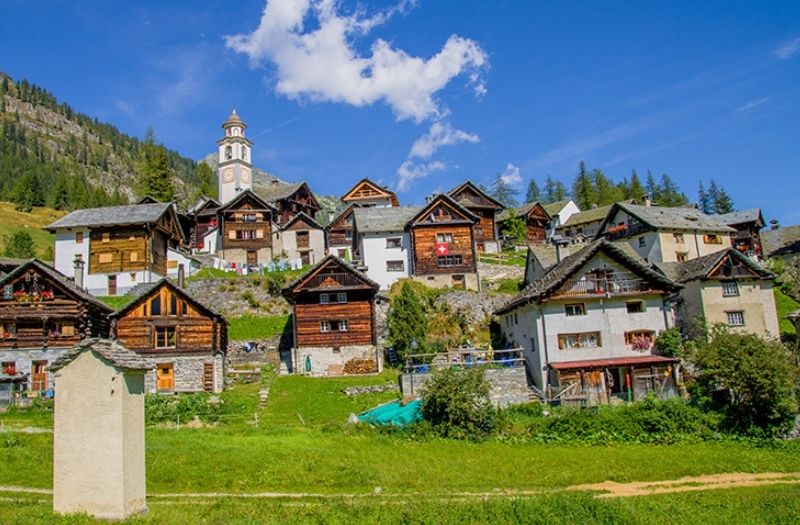
Canton: Ticino
Inhabitants: 60
Notable sites: Parish church, Walser museum, wooden houses
Founded in 1253 by Walser settlers from the Valais, the tiny village of Bosco Gurin is not only the highest commune in Ticino, it is also the only German-speaking commune in the Canton.
Villages in Switzerland don’t come much smaller, or much more idyllic, than this.
The charming village sits in a side valley of the Valle Maggia and, as it has for centuries, agriculture is the main source of income here.
Tourism also plays a role, with the village, which sits at 1,504 metres above sea level, regarded as one of the most popular ski destinations in Ticino.
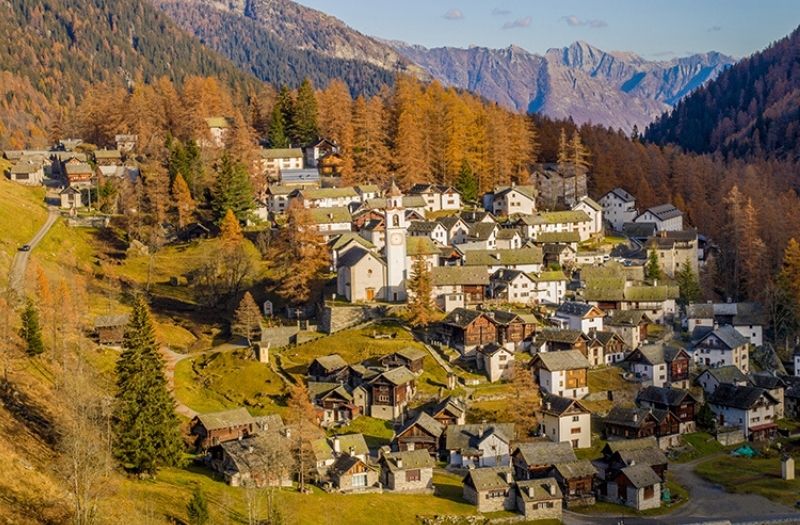
Visitors to Bosco Gurin can’t help but notice the village’s traditional architecture with the houses built of stone and wood. One of the oldest of these houses, which dates back to 1386, is now home to the local history museum.
The traditional language of the villagers is also well preserved with the local dialect Ggurijnartitsch learnt from an early age and is still spoken today.
Where to stay: >> Walser App. 31 Pozzi
Other member villages in Ticino to visit are Morcote, Ascona, and Muggio.
Giornico
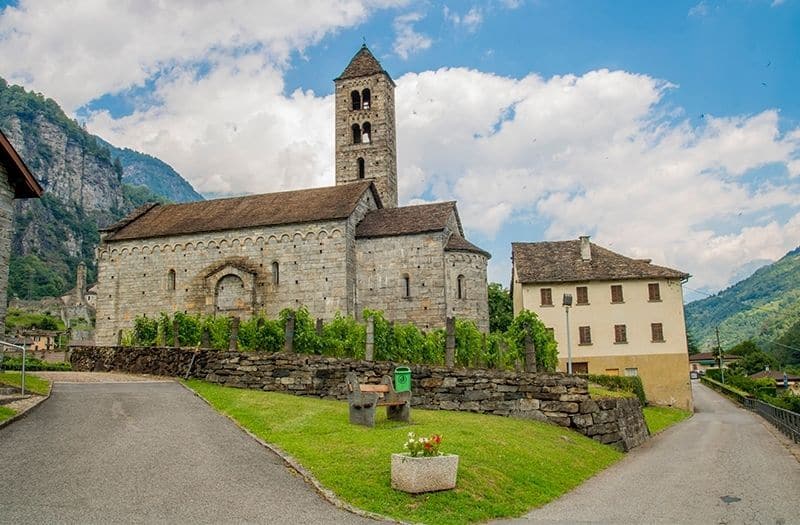
Canton: Ticino
Inhabitants: 1,200
Notable sites: Seven Churches, Museum of Leventina, river island grotto restaurant
Journey time from Bellinzona: by train and bus: 35 minutes / by car: 20 minutes
The canton of Ticino is the only one that lies entirely south of the Alps, and this is an Italian-speaking part of Switzerland. Giornico is a beautiful village around half an hour from Bellinzona, the capital of Ticino.
Known as the village of the Seven Churches, Giornico has some unique houses of worship to see, such as the Romanesque Church of San Nicolau.
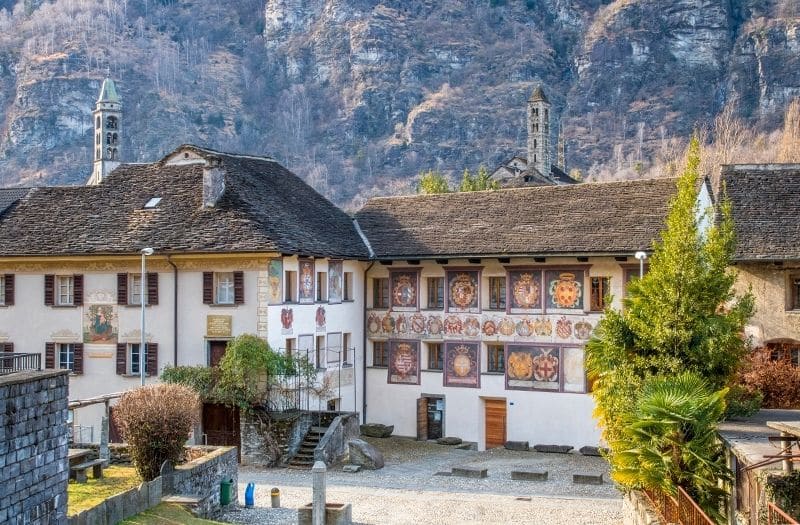
The village was also a popular rest stop in times past for humans and animals making their way to the Gotthard Pass, before they tackled the ascent. Giornico is also home to the Museum of Leventina, which is well worth visiting.
You can also discover Ticino’s only inhabited river island here. This is connected to the mainland via two original mediaeval bridges, and the island also has a grotto, a local restaurant, a little like an Italian trattoria.
Dine here and you can enjoy views of the river and the mediaeval bridges. You can also sample the famous local wine, Giornico Oro, which translates as Giornico Gold. It’s one of the finest Merlots you’ll find anywhere.
Giornico can be reached by car in around 20 minutes, or by train and bus via Biasca. The latter takes around 35 minutes in total.
Saint-Saphorin
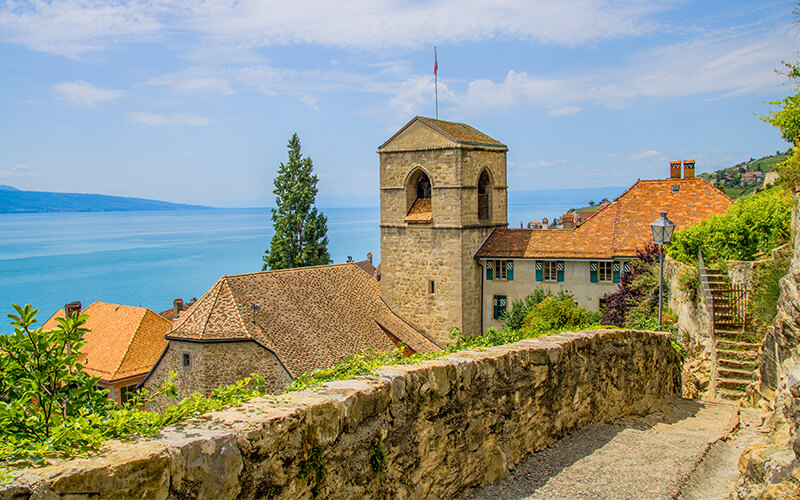
Canton: Vaud
Inhabitants: 390
Notable sites: Evangelical church, UNESCO vineyards, Winemakers’ Cellar
The Swiss village of Saint-Saphorin occupies a dramatic location among the Lavaux terraced vineyards, on a steep hillside above Montreux and overlooking the lake.
Beyond the water, majestic Alpine peaks form a scenic backdrop making this what has to be one of the most beautiful places in Switzerland.
Chances are, if you search the internet for beautiful images of Switzerland, the results will include plenty of photos of Saint-Saphorin.
The Lavaux vineyards are UNESCO World Heritage listed, and fine wine is made right here from the Chasselas grapes.
A highlight of any visit to this village is the winemakers’ cellar, where local vintners allow the sampling of their wares.
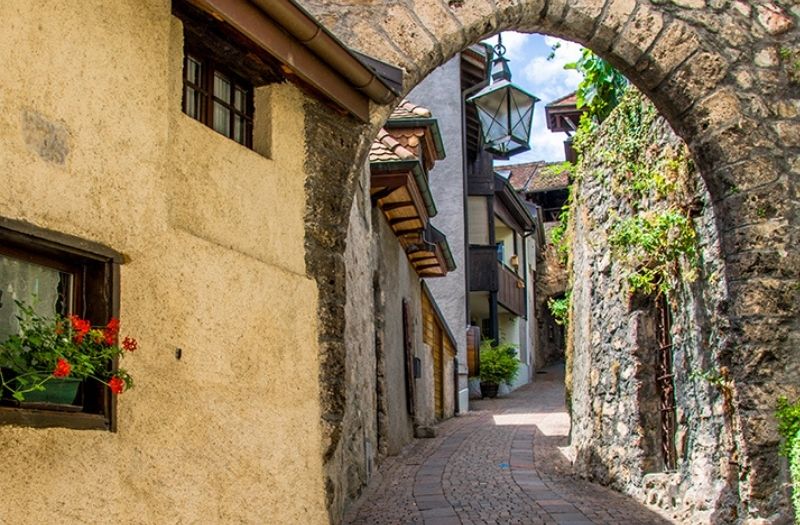
Saint-Saphorin’s old town is a charming area featuring cobbled lanes, narrow alleys and winding passages.
The Evangelical church dates from the early 1500s and occupies a site of historical importance. Formerly, the site was home to a Roman villa and then a medieval sanctuary.
The proximity of the lake’s sparkling waters, the multi-coloured roofs, the tumbling vineyards and the elevated location give the village something of a Mediterranean feel.
Both locals and visitors mingle at the Place du Peuplier or village square or relax at the winemaker’s cellar.
Where to stay: >> Domaine du Burignon
More beautiful villages in Vaud: Avenches, Grandson, Moudon, Romainmôtier, Rougemont and Yvorne.
Grandvillard
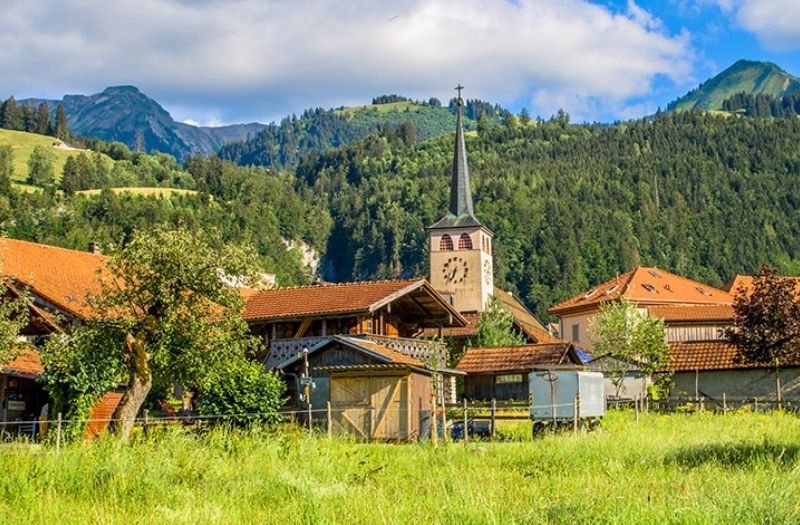
Canton: Fribourg
Inhabitants: 845
Notable sites: Cheese factories, Swiss heritage site houses
Grandvillard is located in the Gruyère region of Fribourg, and as such is famous for its cheesemaking heritage.
The village is also home to some significant buildings, namely those houses that are listed as Swiss heritage sites.
Visitors can take a Rural Architecture Discovery trail through Grandvillard if they wish. Beginning at the Restaurant du Pic Vert, this passes by 14 buildings dating from between the 16th and 20th centuries.
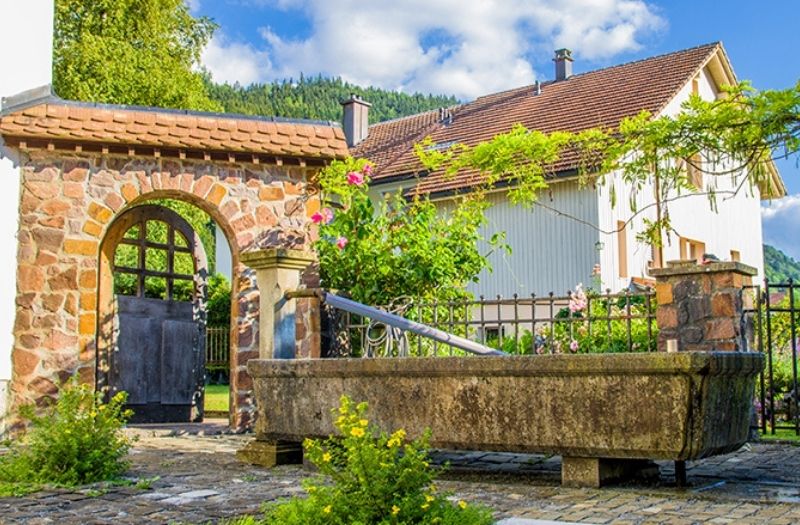
The area’s cheesemaking past is evident on the peasant architecture of the village’s homes and barns. Buildings are rich in stone and wood, and some have gothic-style windows.
The Church of San Bartolomeo and Giacomo is worth visiting, and there are also many small chapels to be found around this mountainous area on the edge of the forest.
Where to stay: >> Hotel du Vanil-Noir
Nearby Gruyères is another of the Most Beautiful Villages in Fribourg.
Valangin
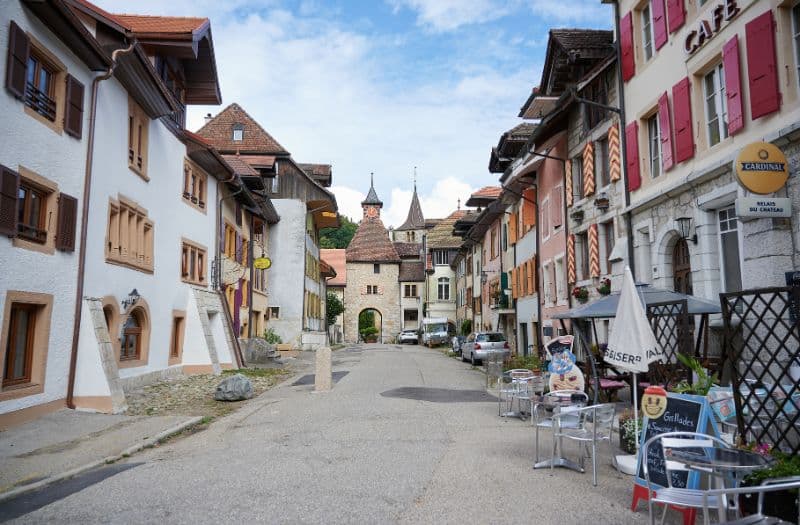
Canton: Neuchâtel
Inhabitants: 505
Notable sites: The Castle, the collegiate Church of St Peter, the Bourg
Valangin’s rich history dates back to at least the 12th century, and the village was governed by the Counts of Aarberg until the late 1500s. The latter constructed the fortified walls, towers and castle.
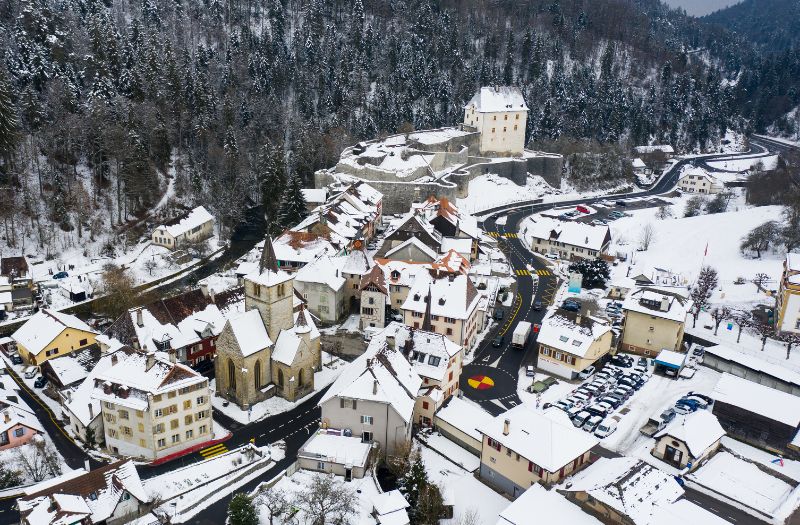
The village enjoys a pleasant and protected position below the hills and among the peaceful Swiss forests.
Many visitors reach Valangin via paths through the trees, before being greeted by the imposing sight of the castle and its walls and towers.
With an idyllic location around 5 kilometres from Lake Neuchâtel and in the heart of the Seyon Gorges, Valangin is a place where many relax and unwind.
The active can hike the nearby first trails, while those interested in history and culture can take in the collegiate church, Bourg and of course the castle.
Saint-Ursanne
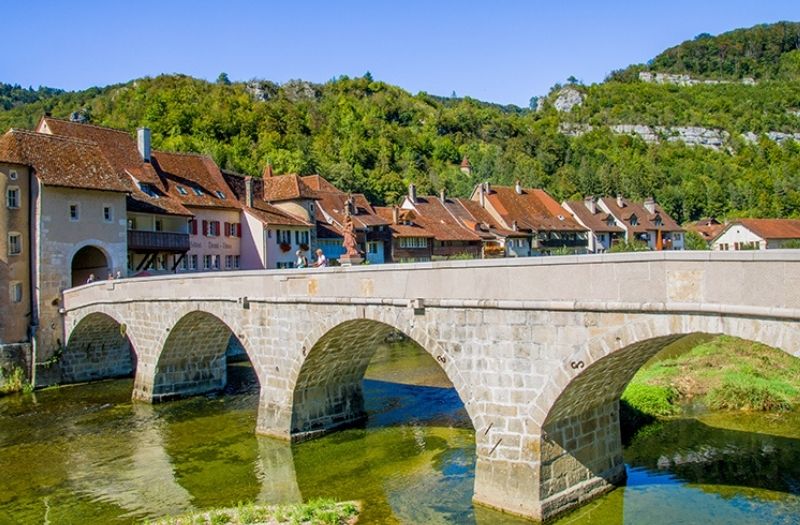
Canton: Jura
Inhabitants: 690
Notable sites: Town Hall, Collegiate Church and Bell Tower, Three City Gates
Occupying a tranquil site by the Doubs river, Saint-Ursanne is a well-preserved Swiss settlement that dates back to Medieval times and is one of the most attractive small towns in Switzerland.
To this day, the old town can only be accessed via four entryways. One of these is the Saint-Jean Népomucène bridge, while the other three are the original city gates.
These are St Peter’s Gate in the east, St John’s Gate to the south and St Paul’s Gate to the west. The latter is sometimes known as the Porrentruy Gate.
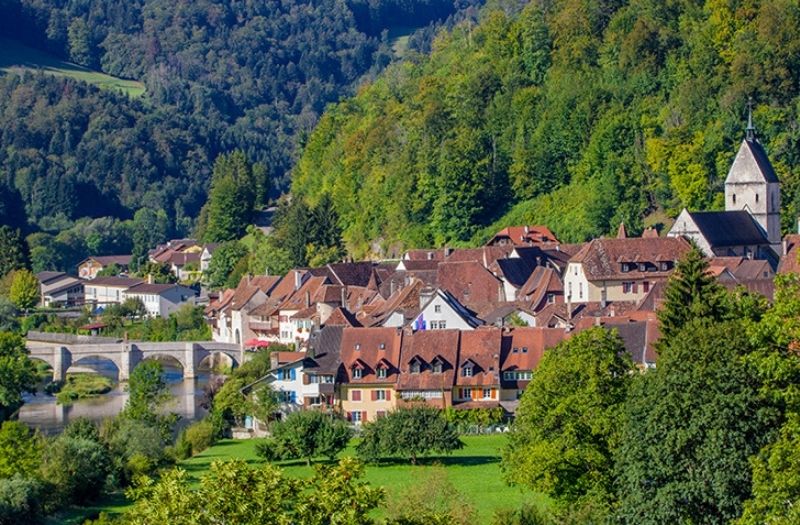
The bridge was subject to renovation in 2016, while the village’s collegiate church and cloister were built in the 1100s and 1200s.
A reminder of the past exists in the form of a medieval garden, where medicinal plants and vegetables are still grown.
Saint-Ursanne is often referred to as the ‘Pearl of the Jura’. It is certainly an attractive village, with ancient pale stone buildings set against a backdrop of lush green trees – all nestled on the banks of the Doubs river.
Where to stay: >> St-Ursanne
Whilst in Jura, why not also visit Porrentruy?
Diessenhofen
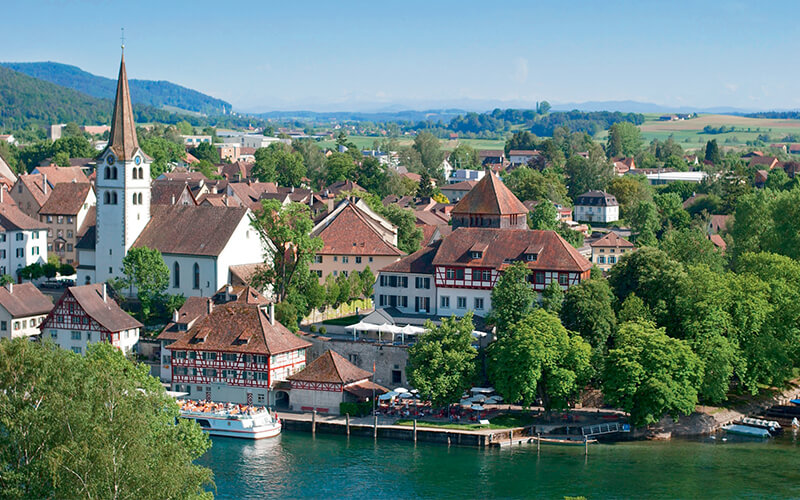
Canton: Thurgau
Inhabitants: 4,000
Notable sites: Wooden Bridge, Castle of Unterhof, Convent of St Katharinental
Diessenhofen is a pretty riverside village located in the Rhine region of Switzerland between the popular towns of Schaffhausen and Stein am Rhein. It is also close to the Rhine Falls.
This is one of the most scenic river landscapes anywhere in the world, and a boat trip along the Rhine is a must for many visitors.
The wooden bridge in Diessenhofen is famous for several reasons. It forms the border between Germany and Switzerland and is over 150 years old.
Passing boats must lower their cabins and awnings as well as masts to pass beneath it unhindered.
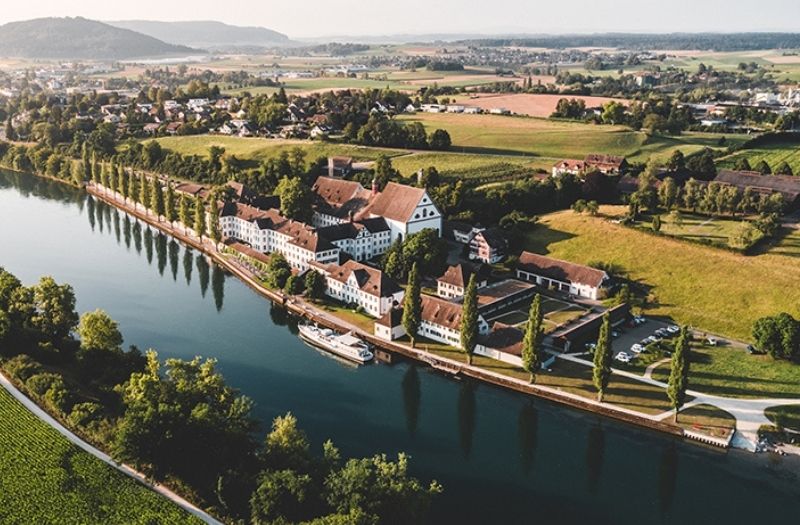
This picturesque Swiss village is surrounded by countryside, which certainly adds to its appeal.
From the banks of the Rhine, visitors can see rolling green hills dotted with the vineyards of this winemaking region as well as castles and other ancient buildings.
A charming footpath leads to the convent of St Katharinental, a Dominincan structure that is Baroque in style within. Unterhof Castle, meanwhile, is a Swiss heritage site of national significance.
Where to stay: >> Sorell Hotel Ruden, Schaffhausen (8km from Diessenhofen)
Simplon Dorf
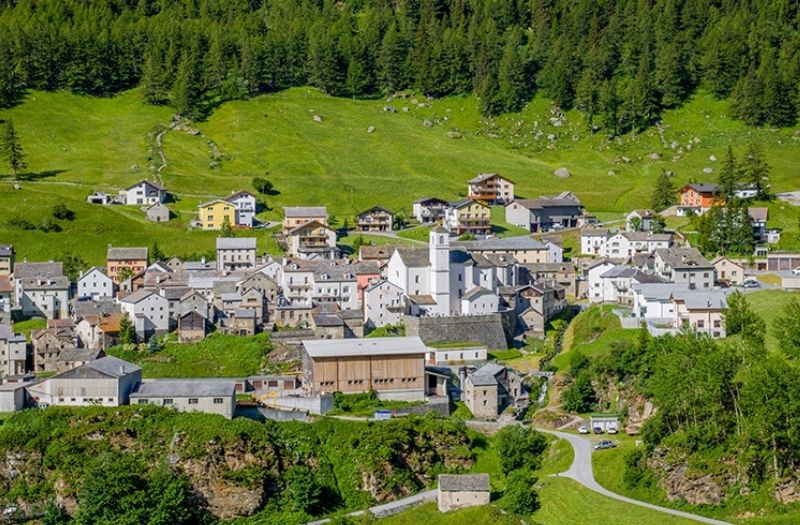
Canton: Valais
Inhabitants: 310
Notable sites: Simplon Pass, Village Square
This Valais village is a Swiss site of national importance. At almost 1,500 metres above sea level, Simplon Dorf lies to the southern end of the Simplon Pass.
There are many nods to nearby Italy in this Swiss village, including the central village square which is Italianate in style. The buildings also have stone slab roofs typical of those found in the neighbouring country.
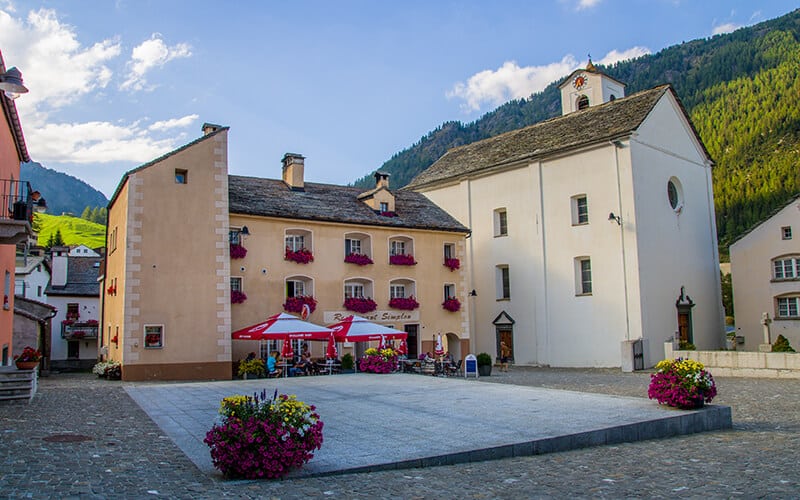
The section of the Simplon Pass that goes via Gondo Gorge is the most spectacular, with granite walls rising high on either side.
Simplon Pass first came into use during the 1600s, when it was first used for pack animals who carried salt from the Mediterranean across the Alps.
Other sites of interest in this village include small churches as well as a dairy and a traditional Swiss bakery.
Where to stay: >> Hotel-Restaurant Grina
There are numerous members of the Most Beautiful Villages in Switzerland in the canton of Valais. Be sure to visit Albinen, Appoint, Evolène, Grimentz and Saillon.
Grimentz
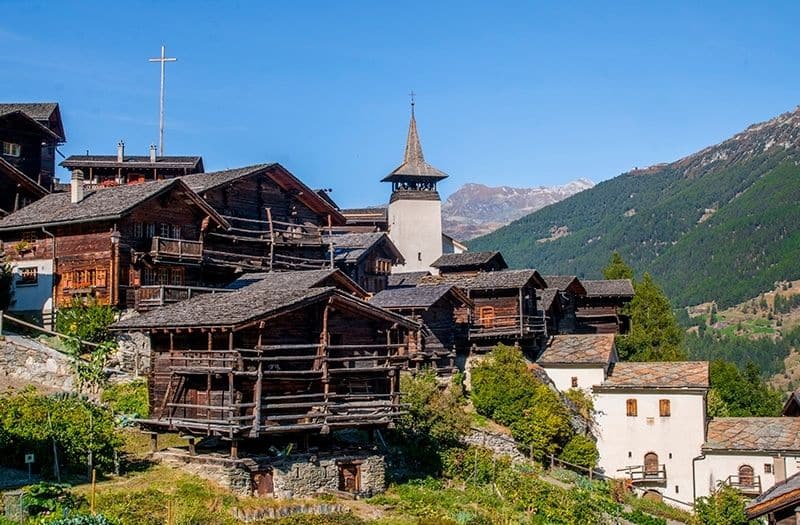
Canton: Valais
Inhabitants: 475
Notable sites: Burgher House & cellar, traditional wooden houses, Moiry Reservoir Lake
Journey time from Sierre: by bus: 1 hour and 50 minutes / by car: 30 minutes
Grimentz is situated in the Swiss canton of Valais, in the scenic Val d’Anniviers region. Grimentz is more than 1,500 metres above sea level, and can be accessed via a mountain road that runs alongside a gorge.
Dating from the mid-16th century, you can discover the Burgher House at the heart of the village. The cellar here is where the local white wine is aged in casks. In the past, this glacier wine was only served when the bishop came to visit the village.
Grimentz has a narrow main street lined with wooden houses, and these are decorated with bright red geraniums in spring and summer. The homes themselves have also been darkened by the powerful rays of the sun.
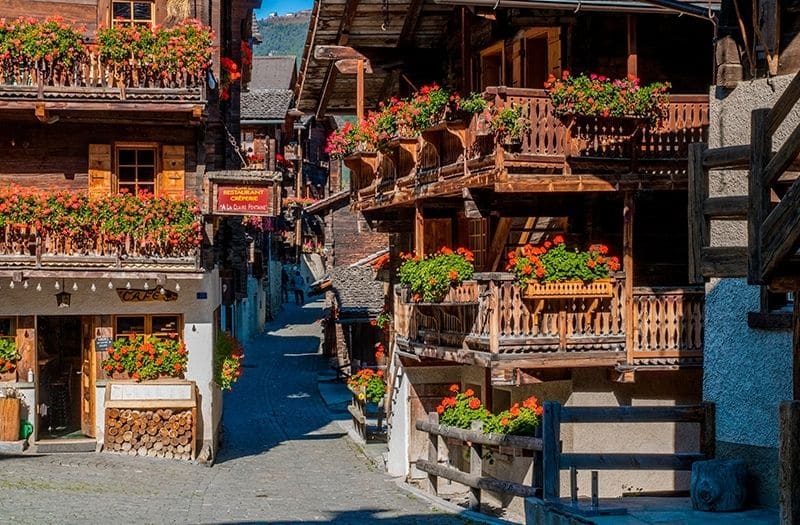
In winter, this is a popular winter sports destination, and the 3,000-metre-plus snowy mountains can be seen looming over the village.
There’s plenty to do in and around Grimentz to warrant a longer stay. You can take a walk to Moiry Reservoir Lake, or sample winter sports such as downhill or cross country skiing and toboggan rides.
You can reach Grimentz by bus from Sierre, or by train from Geneva. The latter takes around two hours and 25 minutes. Alternatively, driving there involves a journey time of about two hours and 10 minutes from Geneva, or, it’s around half an hour by car from Sierre.
Where to stay: >> Hôtel Alpina – Swiss Ski & Bike Lodge Grimentz
Erlach
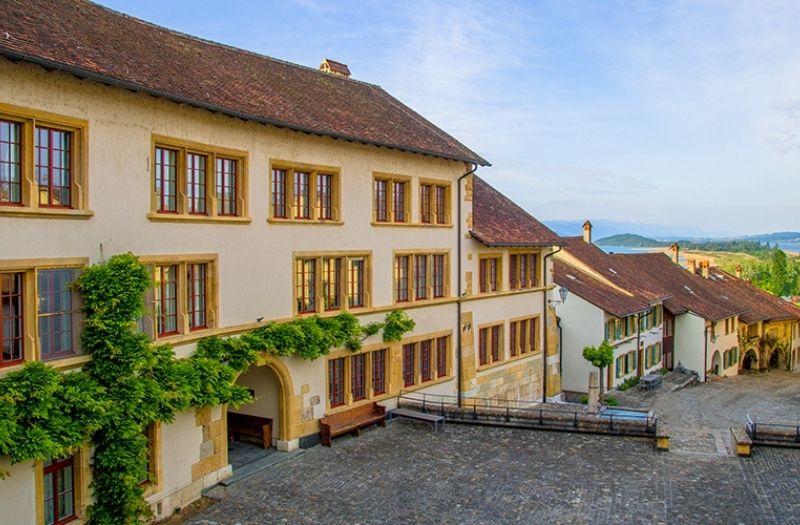
Canton: Bern
Inhabitants: 1,405
Notable sites: Erlach Castle, St Peter’s Island, The Knight’s Hall
Erlach is the ‘Pearl on Lake Biel’ and dates back to the late 11th century.
With its picturesque location and well-preserved medieval architecture, it is considered one of the most charming fairytale towns in Switzerland.
A castle was first built on the site by a bishop from Basel. Now, the Knight’s Hall is a fine example of medieval architecture, with Romanesque pillars supporting the impressive beamed ceiling overhead.
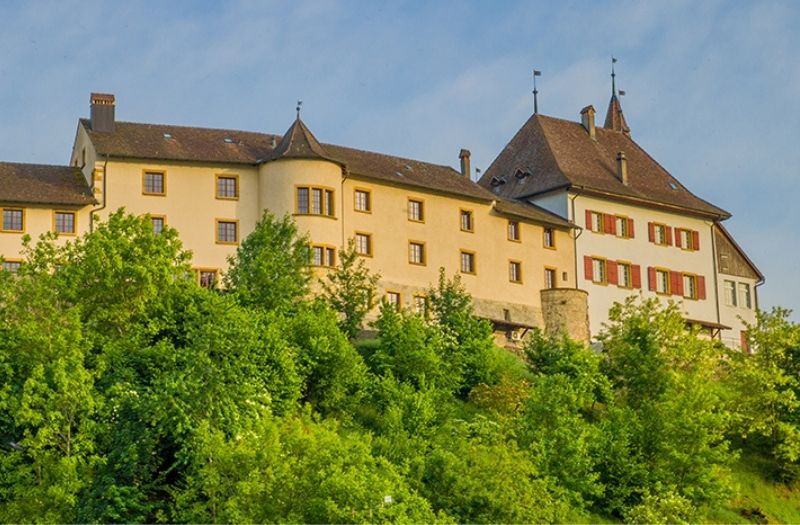
Erlach Castle is one of Bern canton’s oldest. Originally constructed to protect the route towards Lake Biel, it dates from around 1100.
The old town was gradually added to during the 1200s, and by stages it grew into the more sizeable settlement that it is today.
The natural beauty of Lake Biel is one of the draws of Erlach. Fishing is also a popular pastime on the lake. Many like to visit St Peter’s Island, which is now actually a peninsula forming part of Erlach.
It is rich in natural beauty, and famed for its marshes, reed beds and meadows. In the wider area, wine tastings and vineyard tours are other activities enjoyed by many.
Büren an der Aare
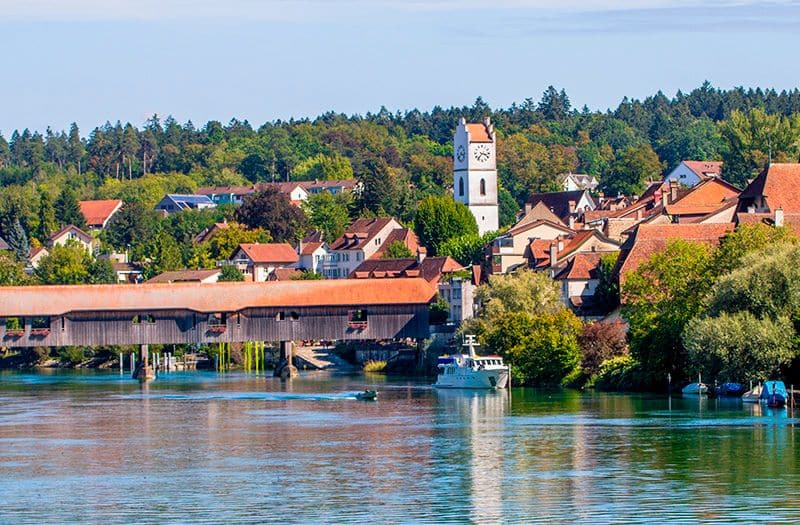
Canton: Bern
Would you like to save this article?
We promise never to spam you.
Inhabitants: 3,220
Notable sites: Mediaeval centre with a town hall, a castle, fountains, an Evangelical church, a museum and a bridge over the Aare
Journey time from Bern: by train: 30 minutes / by car: 30 minutes
Büren an der Aare is listed on the Swiss Federal Inventory of Cultural Property, and has a number of places of interest to its name. This historic village has a mediaeval centre, and was once closed off by the moat which surrounded it.
The village is attractively located on the banks of the Aare River, hence the name. Here the rural meets the urban in a village centre that’s packed with historic buildings and appealing sights. Taking a walk along the riverbank is also an extremely pleasant pastime while visiting the area.
Particular points of interest in Büren an der Aare include the old town hall, a pair of pretty fountains, an ancient castle, the Spittel museum, an Evangelical church and an original wooden bridge spanning the river.
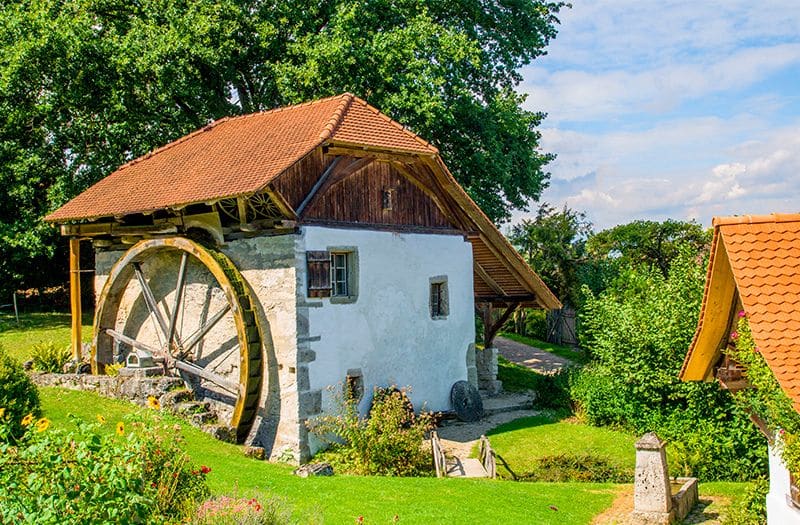
The historic Alte Mühle (old mill) can also be reached on foot in just a few minutes. As well as the historic building, there’s a spacious and scenic garden here to enjoy.
As a larger settlement than some of the most beautiful villages in Switzerland, Büren an der Aare can offer a wider range of amenities. There’s a Büren Tourism office housed in the town hall, plus numerous places to eat and a handful of low-key accommodation options.
In this Swiss village you can also take a trip on the river, sample inline skating, ride a horse, follow a fitness trail or take a dip in the river or local swimming pool.
Büren an der Aare is one of the larger of the most beautiful Swiss villages. With a permanent population of around 3,220, it’s easy to reach from Bern. Getting there from the capital takes only half an hour or so, whether you travel by train or by car.
La Neuveville
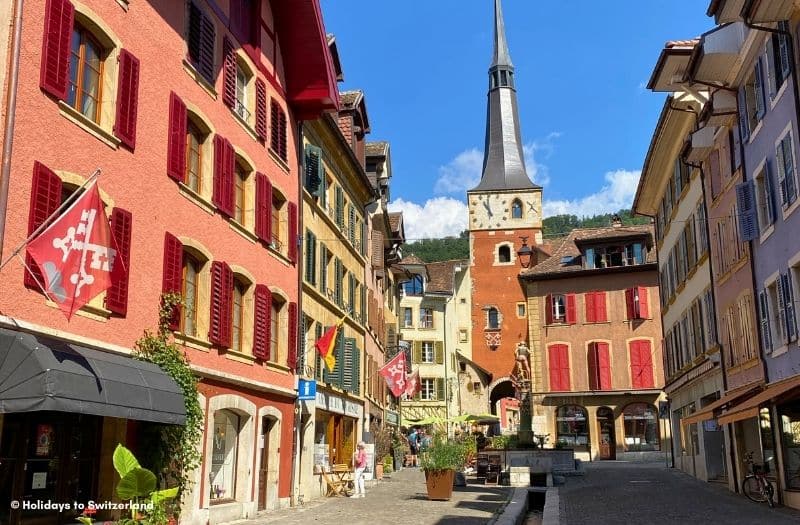
Canton: Bern
Inhabitants: 3,900
Notable sites: Lake Biel, colourful houses, central stream and fountains
Journey time from Bern: by train: 50 minutes / by car: 45 minutes
La Neuveville is one of the most colourful villages in Switzerland, so it really does have the wow factor. Located on the shores of Lake Biel – or Lake Bienne as it’s also known – you’ll also find water in the centre of the village in the form of a small stream and a pretty fountain.
A choice of cafes is also located in the village centre so you can sit awhile, enjoying the relaxed atmosphere.
Somewhat unusually for Switzerland, La Neuveville also has some old towers dating from mediaeval days. These can be found at the entrance to the old town, flanking the walls formed by the rows of gelato-coloured homes.
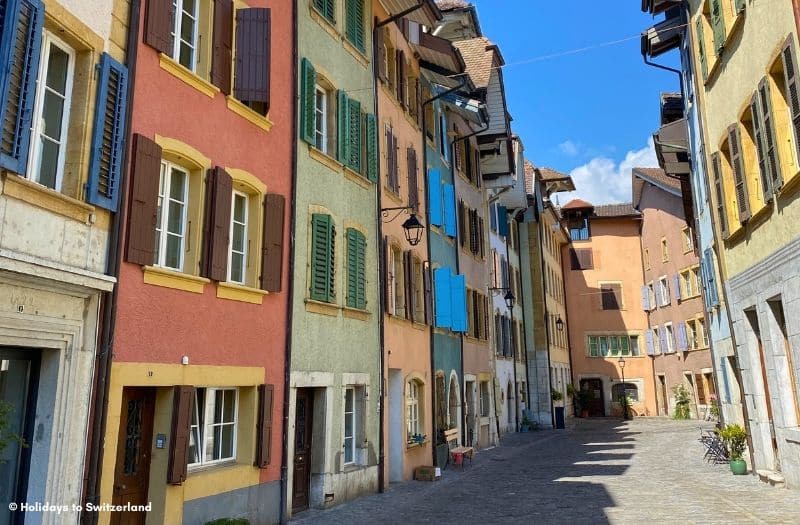
The lakefront is a popular spot for relaxation on warm summer days and it’s here that you can hop aboard a boat for a cruise on Lake Biel.
Although it’s less than an hour from the Swiss capital Bern, reaching La Neuveville by boat is another great option. Boat services connect the towns on Lake Biel year round (except for a one week break at the end of March).
Two other members of the most beautiful villages in Switzerland are very close to La Neuveville – Erlach and Le Landeron – both of which can also be reached by boat.
Where to stay: >> Studios des Arcades
Luthern
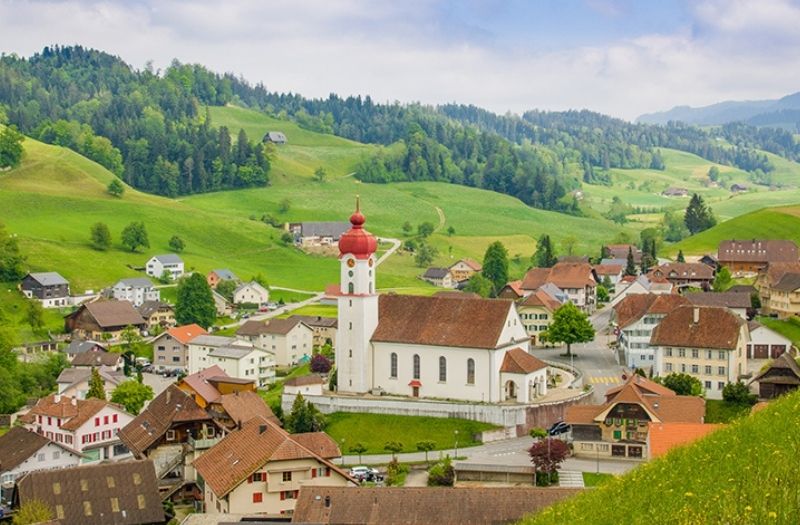
Canton: Lucerne
Inhabitants: 1,280
Notable sites: St Ulrich Church, Luthern Bad
Luthern is centred around a pretty village square with a large, handsome lime tree at its centre.
St Ulrich Church and the nearby buildings of the rectory, parish hall and tithe storehouse complete an idyllic Swiss village scene.
Luthern sits on the border between the cantons of Bern and Lucerne. It is nestled in a sunny valley, surrounded by green hills and woodland.
Below this valley lies Luthern Bad, a pilgrimage site dating back to the late 1500s.
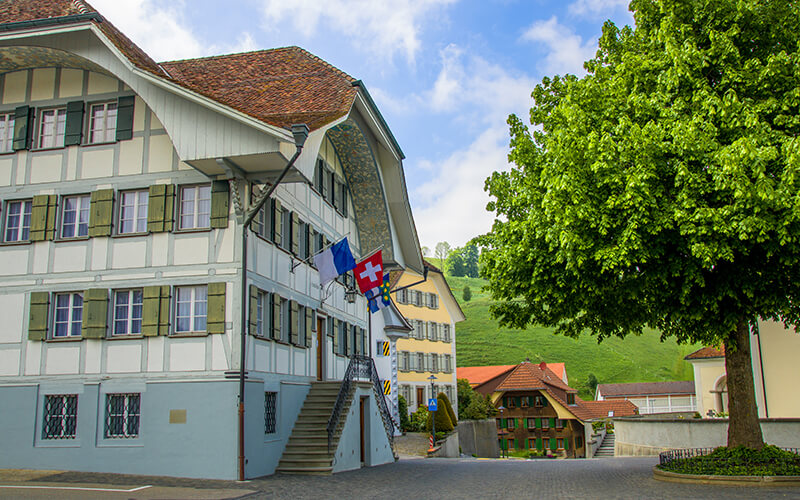
Luthern Bad is not only a destination for pilgrims – its spring water is said to strengthen both the body and mind of anyone who bathes their arms or feet in the custom-made bath.
Visitors to Luthern can take the waters at Luthern Bad, enjoy the majesty of Mt. Napf, appreciate this as a special place of pilgrimage and enjoy the serene and uniquely Swiss scenery.
Where to stay: >> Ferienwohnung Napf-Chasi
Gersau
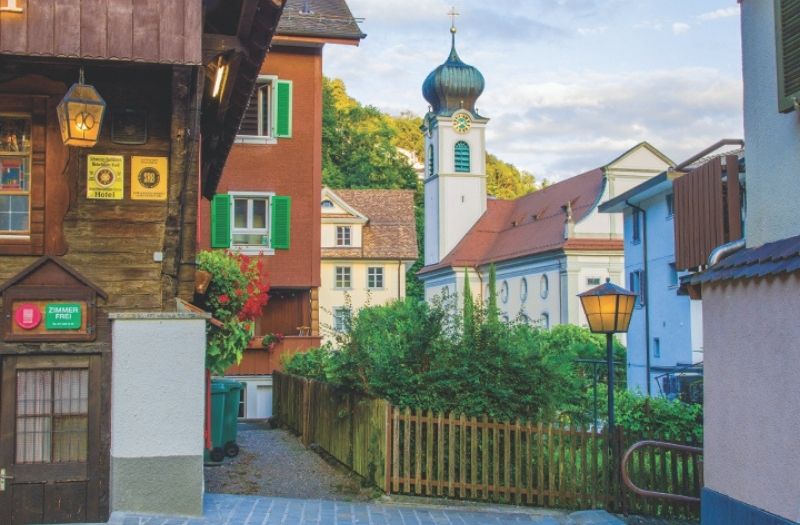
Canton: Schwyz
Inhabitants: 2,330
Notable sites: Lake Lucerne, Mount Rigi, Municipal Museum
Abundant in natural beauty thanks to its proximity to Lake Lucerne, Gersau is also a starting point for trips up Mount Rigi.
It was also once the world’s smallest republic. The Republic of Altfrye once occupied an area of just 24 square kilometres.
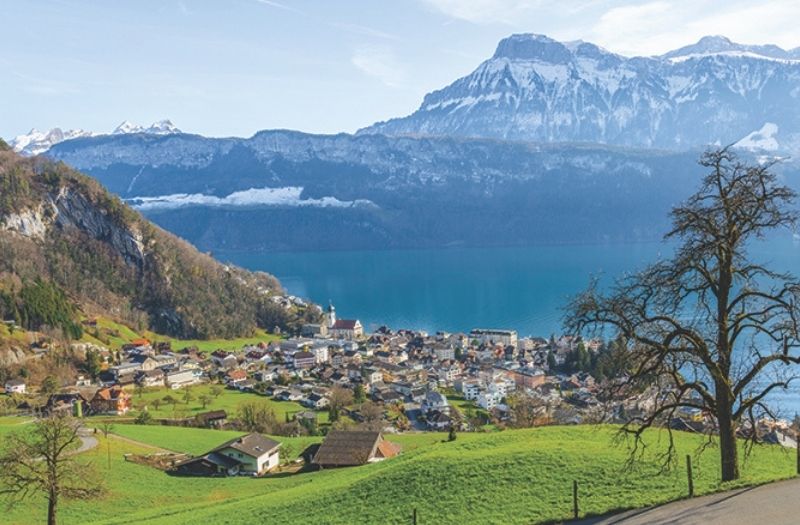
Now, it is a Swiss village with a Mediterranean air. Not least because of the palm and fig trees that flourish in the mild climate and can be seen in front gardens as well as the parks.
This relatively warm weather explains why the village is also sometimes called ‘The Riviera of Switzerland’.
The warm welcome extended to guests is also a notable feature of any visit to Gersau. The locals love to show off their beautiful Swiss village.
If that piques your interest in local history, then the municipal museum is worth a visit.
Where to stay: >> Apartment Seeblick
Grüningen
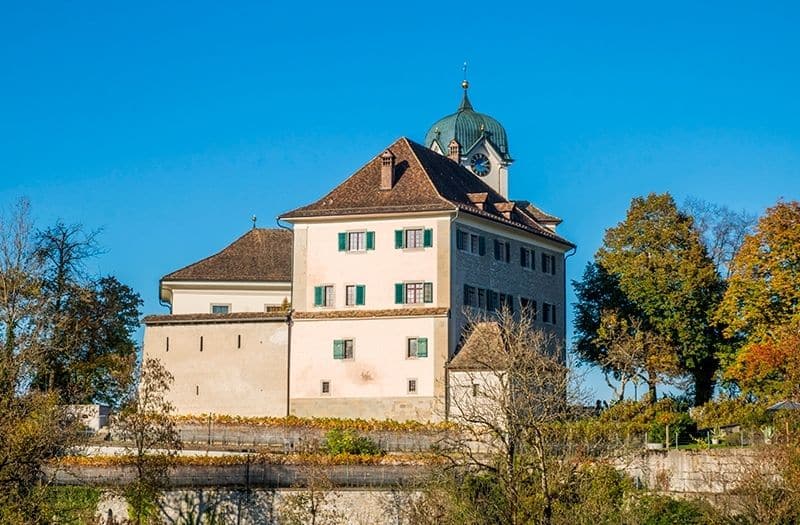
Canton: Zurich
Inhabitants: 3,800
Notable sites: Botanical garden, Grüningen Castle and cafe, historic white homes
Journey time from Zurich: by train and bus: 40 minutes / by car: 20 minutes
Grüningen makes the perfect day trip for anyone who’ll be based in Zurich while visiting Switzerland. The journey from the city by car or public transport is a pleasant one.
If you go by train, you’ll arrive in Wetzikon, and from there you can catch a bus to Grüningen. Otherwise, the drive takes only 20 minutes or so.
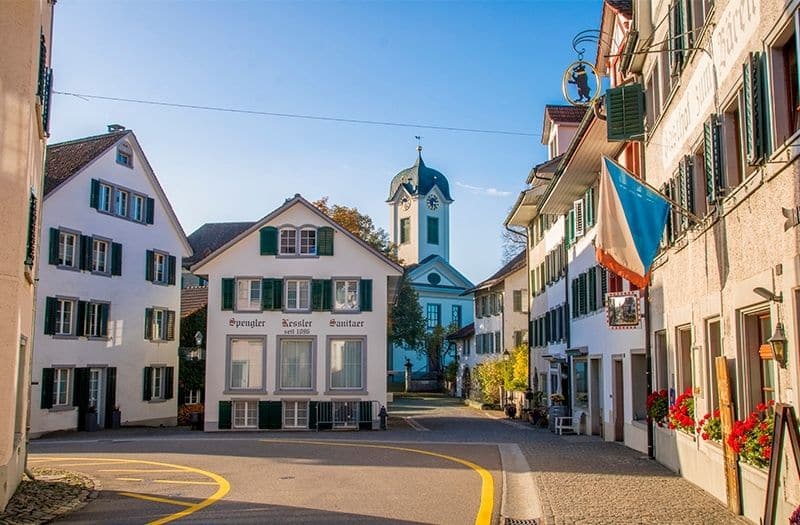
With about 3,800 inhabitants, Grüningen offers several reasons to visit, apart from its sheer beauty. There are regular markets held in the village. Between March and November, you can also explore the well-known botanical garden here.
Grüningen also has a museum housed in a castle, and there’s also a lovely, traditional style cafe in the basement. There’s no fee payable to enter the castle, and the appealing grounds are also ideal for taking a stroll around.
The joy of visiting Grüningen is the slow pace of life, where you can simply unwind with coffee and a slice of cake. In the centre of the village, you’ll also find a row of photogenic, historic white houses.
Sunday is the ideal day to visit if you want to experience Grüningen at its laid-back best.
Tschlin
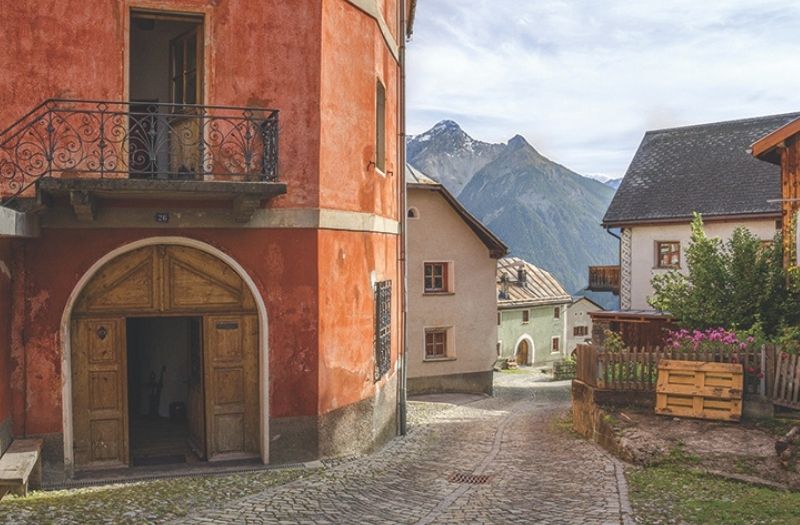
Canton: Graübunden
Inhabitants: 448
Notable sites: The late-Gothic church, Donna Lupa fountain,
Sitting on a sunny terrace at 1,500 metres and overlooking the Lower Engadine and the River Inn, is the picturesque village of Tschlin.
The village has an interesting history and has been known over the centuries by many names including Ciline, de Sline and Schlines, and until 1943, was known by the German name, Schleins.
Tschlin is a well-preserved traditional Graubunden village, the main feature being the late-Gothic church with a polygonal choir and early 16th century frescoes.
In front of the church, the Donna Lupa fountain takes centre stage.
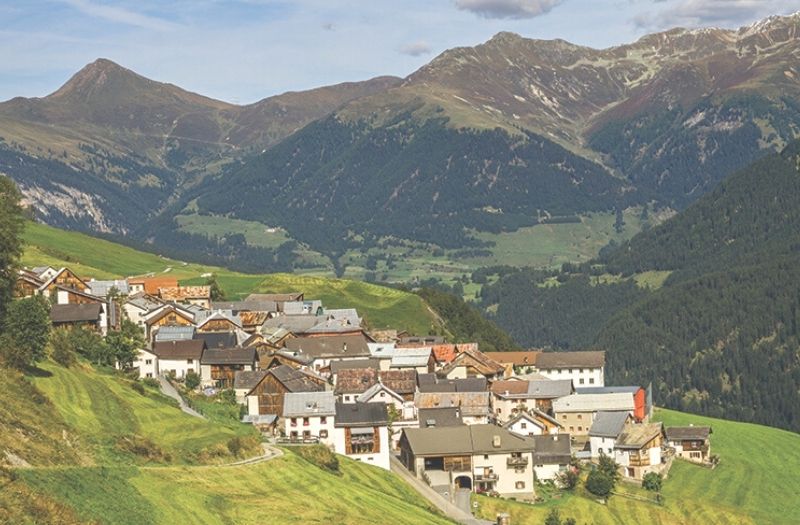
Tschlin’s cobbled streets are lined with beautifully kept houses with decorated facades and the pristine landscape around the village is ideal for hiking, with many trails to be found nearby.
The area is also a haven for birdlife, and the views across to nearby Austria are breathtaking.
Definitely worth visiting is Alpenbrauerei GIRUN, Tschlin’s own alpine brewery. Pop in for a guided tour and tasting of both the specially brewed beer and local produce.
Where to stay: >> Ferienwohnung Caviezel
The canton of Graübunden has six members of the Most Beautiful Villages of Switzerland. The other five are Bergün-Bravuogn, Breil-Brigels, Madulain, Poschiavo, Soglio and Splügen.
Bergün
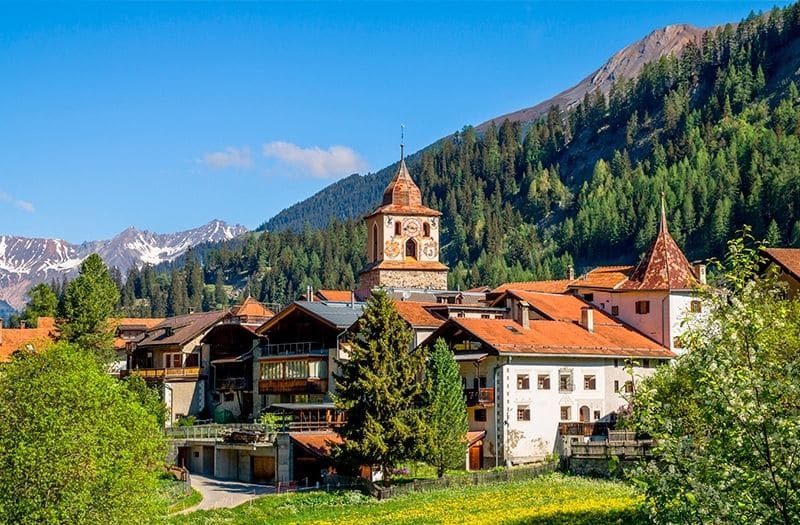
Canton: Graubünden
Inhabitants: 480
Notable sites: Typical Alpine village, Engadine architecture, Europe’s longest toboggan run
Journey time from Chur: by train: 1 hour and 15 minutes / by car: 40 minutes
The canton of Graubünden is famous for its Alpine landscapes and winter sports resorts, as Davos and St Moritz can be found here.
Nestled amongst the Alps is Bergün, a quintessential Swiss village. The village is around 1,400 metres above sea level and has a small population of about 480 permanent residents.
Bergün is located on the UNESCO-listed Albula train line connecting Chur and St. Moritz, the route of the famous Bernina Express and Glacier Express trains.
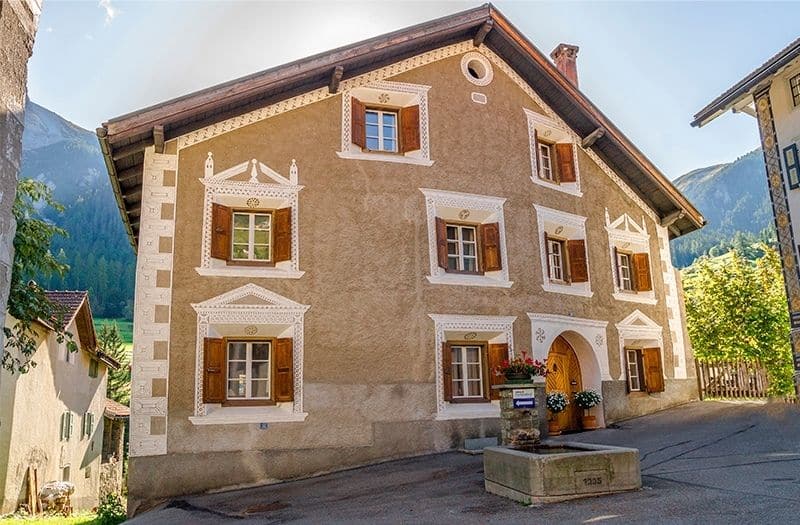
Bergün used to be a popular stop with those who wanted to acclimatise to Alpine altitudes gradually before reaching the Engadine.
Now Bergün has a historic courthouse that was once a hotel, a 13th century tower and a large number of Engadine style houses, even though the village is not in Engadine as such.
In winter, you can also find the longest toboggan run in Europe here. This operates between late November and late March.
You cannot drive in Bergün during winter due to the amount of snow, so it’s necessary to take the train up to Preda and then sledge back down. The train trip also takes place on the canton’s famous Red Train service.
It takes about an hour and 15 minutes to reach Bergün from Chur via direct train, or you can drive there in around 40 minutes.
Lichtensteig
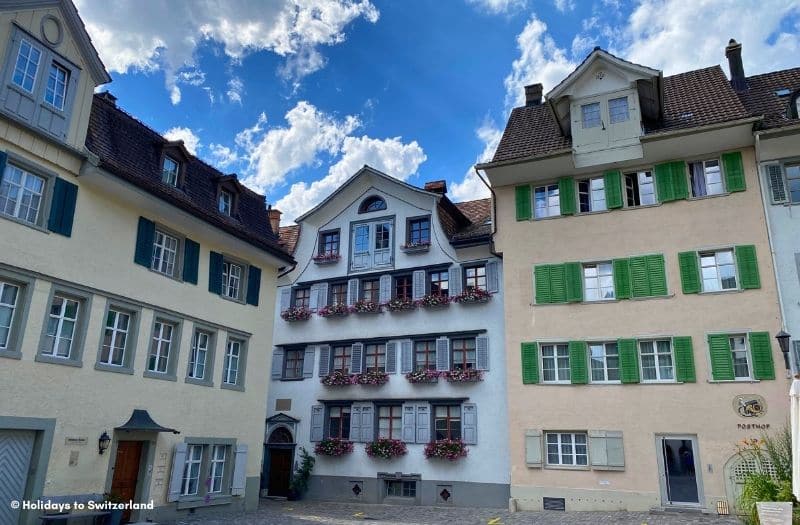
Canton: St. Gallen
Inhabitants: 1,907
Notable sites: Old Town, Town Hall, Loreto Chapel, Toggenburg Museum, Äuli Gorge
Perched on a rocky spur above the River Thur, the market town of Lichtensteig is built in a semi-circle and was once ringed by moats and boundary walls.
The 13th century town centre, with its white houses topped with red roofs, is perfectly preserved and features narrow streets, high arcades and numerous fountains.
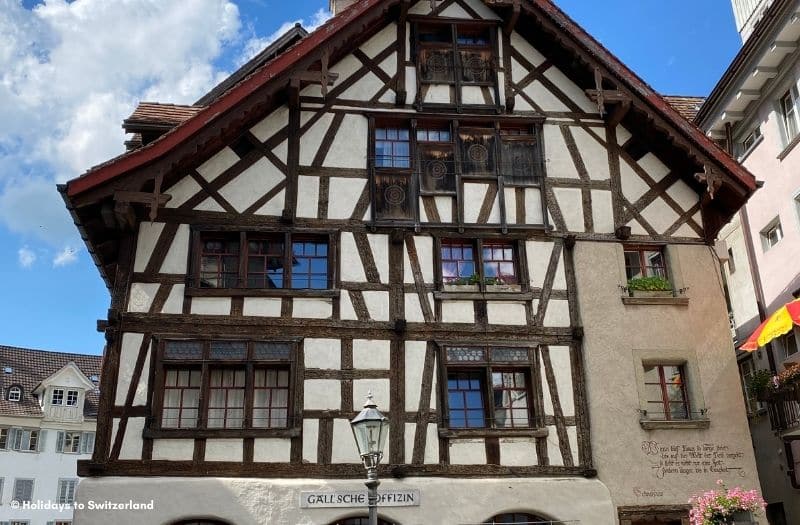
There are a number of buildings of importance in Lichtensteig including the Rathaus (Town Hall) and the baroque Loreto Chapel which is crowned by turrets, whilst the Toggenburg Museum is the place to head to learn about the history of the village.
One of Lichtensteig’s natural highlights is the Äuli Gorge, where the River Thur has carved its way through the land. Surrounded by forest, the gorge’s hidden ravines and waterholes are the ideal place to soak in the beauty of the area.
Where to stay: >> Destimotel
Planning a trip to Switzerland?
At Holidays to Switzerland we are passionate about sharing our love of Switzerland and helping you to plan the perfect trip. Read our guide to planning a trip to Switzerland to kick start your travel plans and join our free Switzerland Travel Planning group on Facebook to chat with other past and future travellers.
Want monthly news and podcast updates, helpful travel tips and special deals sent straight to your inbox? Subscribe to Holidays to Switzerland and we’ll send you a bonus copy of our 21 Useful Things to Know Before You Visit Switzerland guide.
🇨🇭 Check out our exclusive discount offers and save on your Swiss vacation. 🇨🇭
Schwellbrunn
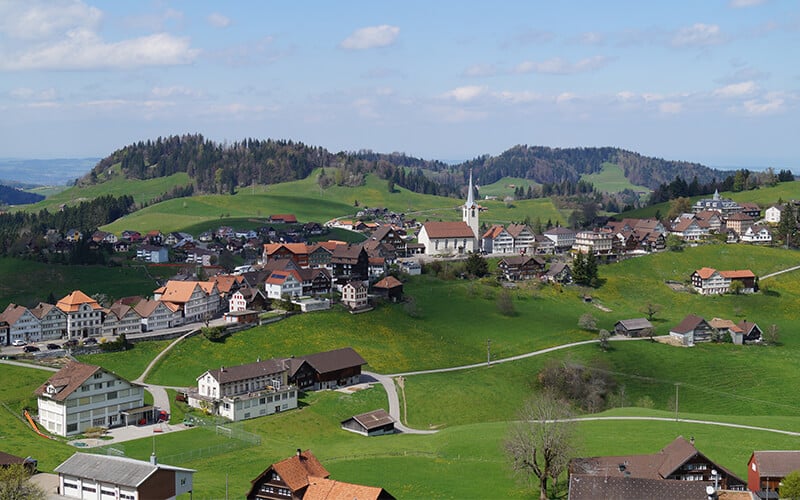
Canton: Appenzell Ausserrhoden
Inhabitants: 1,541
Notable sites: 16th century church, lower Mill, Puzzle Trail
With a backdrop of lush green fields and views stretching as far as the Alpstein and Lake Constance, the charming village of Schwellbrunn is one of the most picturesque in Switzerland.
The village is a heritage site of national significance thanks to its beautiful houses with their historic detail.
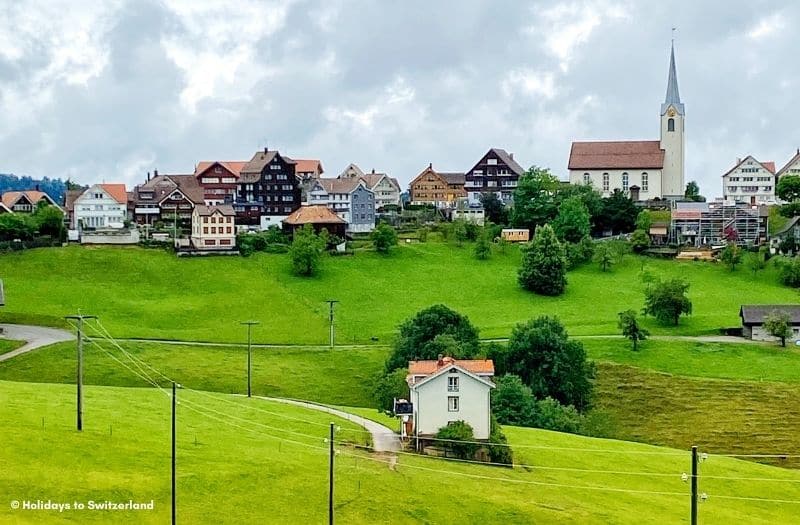
Traditional customs play a big role in the lives of folks from Appenzell Ausserrhoden and the villagers of Schwellbrunn embrace their cultural heritage, too.
Agriculture and gastronomy are highly regarded pastimes with cows from the surrounding fields contributing to the famous Appenzell cheese.
Hiking opportunities abound in the area with a number of different trails on offer including the family-friendly Puzzle Trail. In winter time, skiing, snowshoeing and sledding are popular activities to enjoy outdoors.
Schwellbrunn is the highest village in Appenzell Ausserhoden and with its small village ambience, it’s bound to charm you.
Where to stay: >> Hotel Garni Traube
Whilst in Appenzell Ausserrhoden, be sure to also visit the village of Trogen, which you can read about here.
Triesenberg
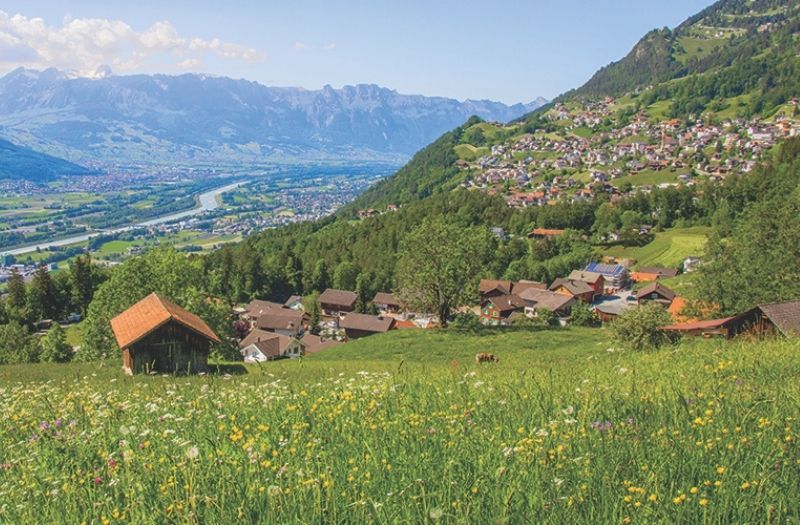
Country: Principality of Liechtenstein
Inhabitants: 2,660
Notable sites: Parish church, Walser Museum, traditional Walser houses
The only member of the Most Beautiful Villages in Switzerland association that isn’t actually in Switzerland, Triesenberg is a worthy inclusion just the same.
Dating back to 1280 when it was settled by the Walsers, Triesenberg sits above the capital Vaduz and the River Rhine.
The locals speak a well-preserved Walser dialect and are very proud of their Walser heritage.
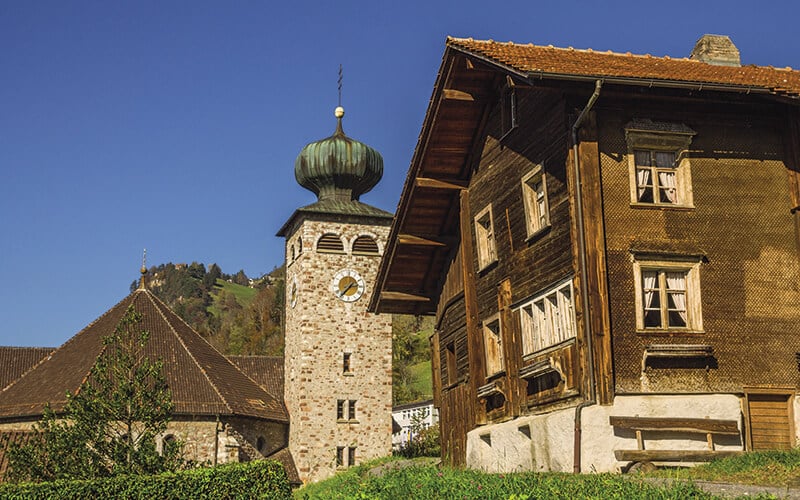
Visitors can learn more about the history and customs of the Walsers in the informative Walser Museum in the heart of the village.
The museum features a 400-year-old Walser house, a collection of historic objects and an interactive display.
Another significant building in Triesenberg is the attractive St. Joseph’s Parish Church with its distinctive green onion dome. The wooden interior is well worth admiring.
Surrounded by mountains and rolling fields, Triesenberg is a popular destination for Liechtensteiners who come to enjoy the unspoilt nature and soak up the sun in the village regarded as Liechtenstein’s sun terrace.
Where to stay: >> Hotel Oberland
Dardagny
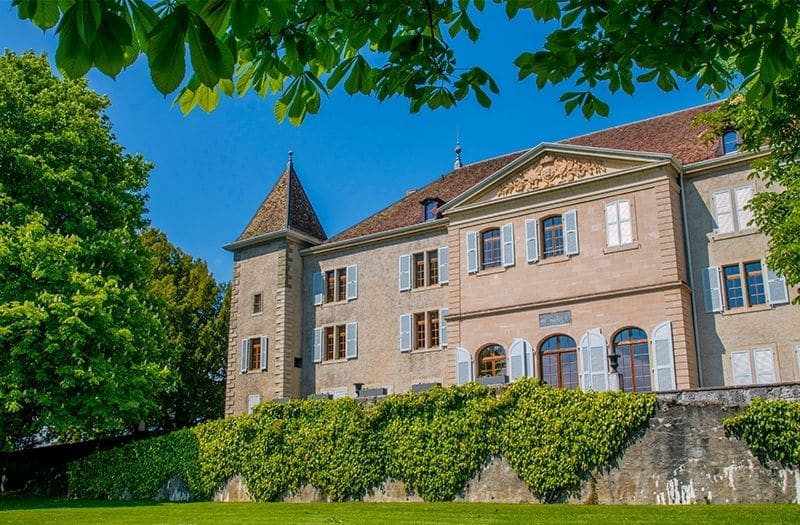
Canton: Geneva
Inhabitants: 1,800
Notable sites: Dardagny Castle, wine cellars, old cottages and chapels
Journey time from Geneva: by train and bus: 35 minutes / by car: 30 minutes
Dardagny is a recent addition to Les Plus Beaux Villages de Suisse association. It’s close to France, and very easy to reach from Geneva.
A sizable and beautiful 17th century castle can be found at the heart of the village, and the town hall’s administrative offices are now housed within the fortress. Dardagny Castle is a Swiss heritage site of national significance, and is the biggest in Geneva canton.
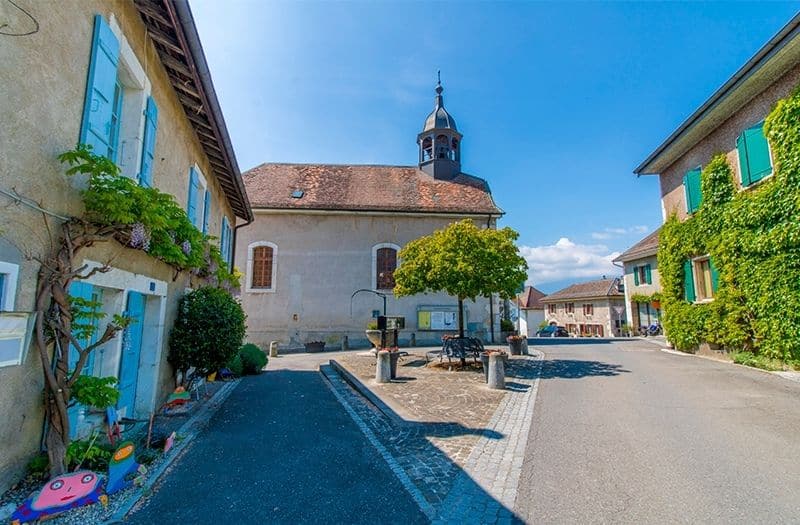
The village is a peaceful place, with only around 1,800 residents. Other than the castle, local attractions include several cellars which invite visitors to sample Swiss wines, and the village is surrounded by vineyards.
You can also wander among the charming old cottages and chapels, one of which dates back to the 13th century.
Dardagny has a very different vibe to the hustle and bustle of Geneva, so it makes a pleasing contrast when you take a side trip from the city. Though it’s only about half an hour away, it feels like another world.
Trains depart from Geneva’s main station twice per hour.
Dardagny is the perfect Swiss day trip destination from Geneva. It’s not at all difficult to fit it into your itinerary, even when you only have half a day to spare.
Where to stay: >> Domaine de Châteauvieux
Arlesheim
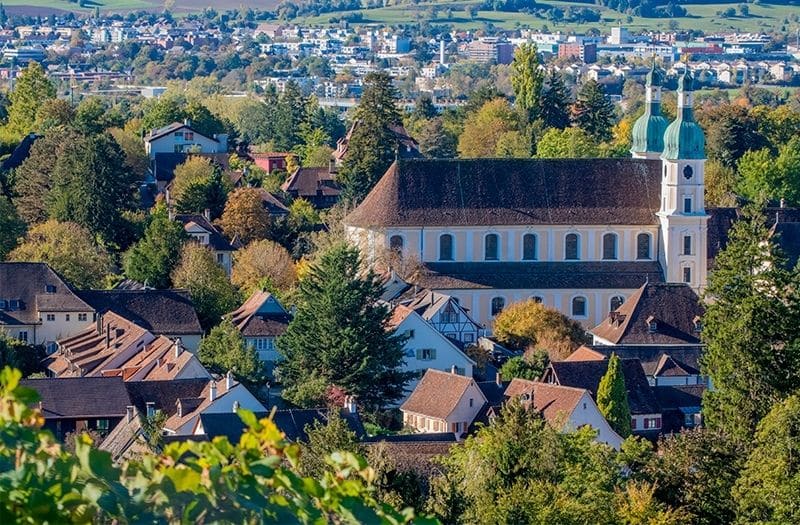
Canton: Baselland
Inhabitants: 8,900
Notable sites: Central square, English gardens, Baroque Cathedral
Journey time from Basel: by tram: 15 minutes / by train: 10 minutes / by car: 15 minutes
In the northern Swiss canton of Baselland is Arlesheim, the most recent village to join the Most Beautiful Villages in Switzerland association. It’s really quick to get to from central Basel, as the trip by tram takes only 15 minutes.
Despite the short distance, Arlesheim feels very much like a village and therefore is very different from busy Basel. At the centre is an attractive pedestrian square with a monumental fountain, where you can grab a coffee from one of the local bakeries.
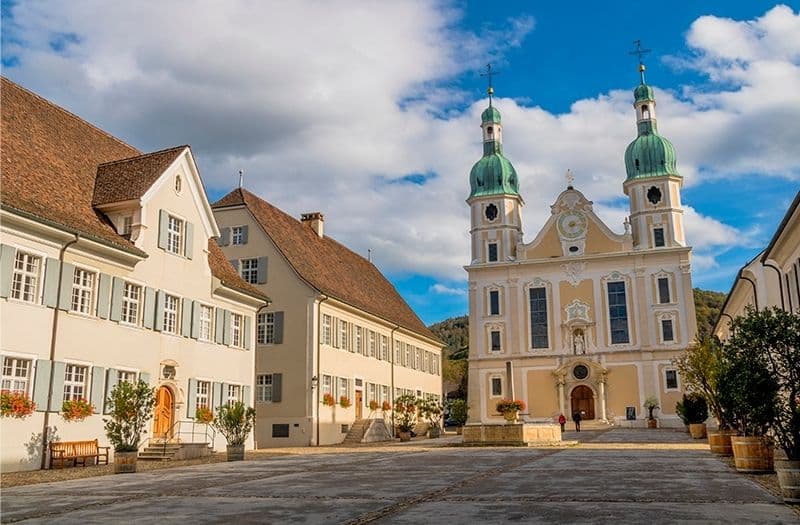
Once you’ve refuelled, you can follow one of several paths from the square that lead to the biggest English gardens in Switzerland. The idyllic gardens occupy a large plot, and are very much authentically English in style.
A vast, monumental Baroque Cathedral is also one of Arlesheim’s true gems. This overlooks the central square of this very walkable village.
Where to stay: >> Hotel Gasthof zum Ochsen
Most Beautiful Villages in Switzerland ~ Final Thoughts
As you can see from the villages featured above, the common theme of history, culture and charm makes all these villages worthy members of the Les Plus Beaux Villages de Suisse.
Spread across the whole of Switzerland, there is sure to be a village close to where your Swiss travels take you. I encourage you to visit one or more of these villages and appreciate their beauty first hand.
Podcast: Interviews with Kevin Quattropani, President of The Most Beautiful Villages in Switzerland
If you’d like to learn more about some of the villages mentioned above, listen to our podcast episodes where we chatted with Kevin Quattropani, president of the Most Beautiful Villages in Switzerland association.
Click the links below to listen.
- Episode 16 – Most Beautiful Villages in Switzerland
- Episode 88 – Switzerland’s Hidden Charms: Exploring Enchanting Villages
Complete list of the Most Beautiful Villages in Switzerland
Western Switzerland
- Avenches – Vaud
- Bursins – Vaud
- Grandson – Vaud
- Moudon – Vaud
- Romainmôtier – Vaud
- Rougemont – Vaud
- Saint-Saphorin – Vaud
- Yvorne – Vaud
- Grandvillard – Fribourg
- Gruyères – Fribourg
- Le Landeron – Neuchâtel
- Valangin – Neuchâtel
- Porrentruy – Jura
- Saint-Ursanne – Jura
- Daradagny – Geneva
Mittelland, Bernese Oberland and Valais
- Büren on the Aare – Bern
- Erlach – Bern
- La Neuveville – Bern
- Albinen – Valais
- Ernen – Valais
- Evolène – Valais
- Grimentz – Valais
- Saillon – Valais
- Simplon village – Valais
- Niedergesteln – Valais
Central Switzerland and Ticino
- Aarburg – Aargau
- Bremgarten – Aargau
- Luthern – Lucerne
- Gersau – Schwyz
- Morcote – Ticino
- Ascona – Ticino
- Bosco Gurin – Ticino
- Muggio – Ticino
- Giornico – Ticino
- Hospental – Uri
Northern Switzerland
- Arlesheim – Basel
- Grüningen – Zurich
Eastern Switzerland and Graubünden
- Bergün-Bravuogn – Graubünden
- Breil-Brigels – Graubünden
- Madulain – Graubünden
- Poschiavo – Graübunden
- Soglio – Graubünden
- Splügen – Graubünden
- Tschlin – Graubünden
- Diessenhofen – Thurgau
- Lichtensteig – St Gallen
- Schwellbrunn – Appenzell Ausserrhoden
- Trogen – Appenzell Ausserrhoden
Liechtenstein
- Planken – Liechtenstein
- Triesenberg – Liechtenstein
